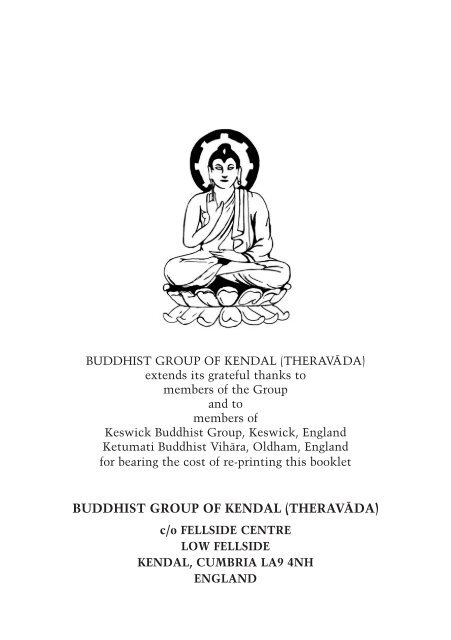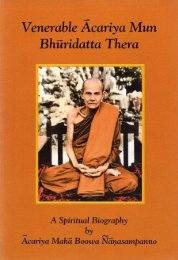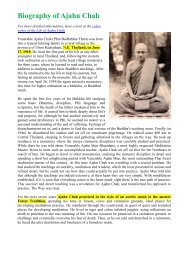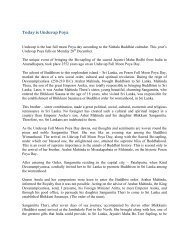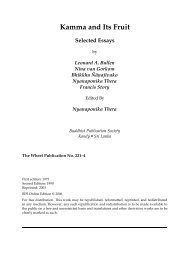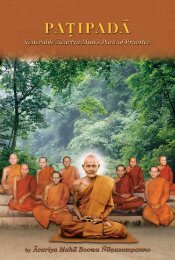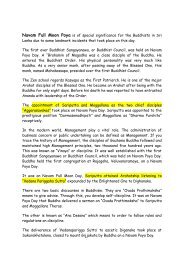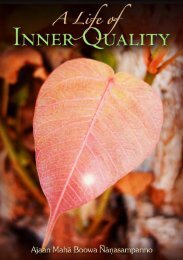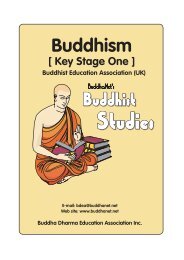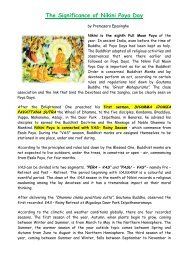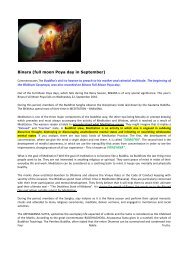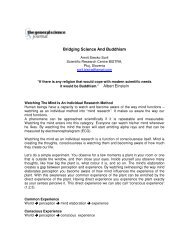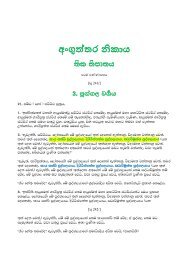buddhist group of kendal (therava¯ da) introducing buddhism
buddhist group of kendal (therava¯ da) introducing buddhism
buddhist group of kendal (therava¯ da) introducing buddhism
Create successful ePaper yourself
Turn your PDF publications into a flip-book with our unique Google optimized e-Paper software.
BUDDHIST GROUP OF KENDAL (THERAVĀDA)<br />
extends its grateful thanks to<br />
members <strong>of</strong> the Group<br />
and to<br />
members <strong>of</strong><br />
Keswick Buddhist Group, Keswick, England<br />
Ketumati Buddhist Vihāra, Oldham, England<br />
for bearing the cost <strong>of</strong> re-printing this booklet<br />
BUDDHIST GROUP OF KENDAL (THERAVĀDA)<br />
c/o FELLSIDE CENTRE<br />
LOW FELLSIDE<br />
KENDAL, CUMBRIA LA9 4NH<br />
ENGLAND
BUDDHIST GROUP OF KENDAL<br />
(THERAVĀDA)<br />
INTRODUCING<br />
BUDDHISM<br />
Venerable Dr Balango<strong>da</strong> Ānan<strong>da</strong> Maitreya<br />
Mahānāyaka Thera Abhidhaja Maharatthaguru<br />
Aggamahā Pandita DLitt D Litt (1896-1998)<br />
··<br />
and<br />
Jayasili (Jacquetta Gomes BA DipLib MLS FRAS ALA)
INTRODUCING BUDDHISM<br />
Contents<br />
What is Buddhism? ............................................................................. 2<br />
The Four Noble Truths ....................................................................... 4<br />
The Eightfold Path .............................................................................. 6<br />
The History and the Disposition <strong>of</strong> Traditions ................................. 8<br />
The Three Basic Facts <strong>of</strong> Existence ................................................... 10<br />
Buddhist Meditation ........................................................................... 12<br />
The Buddhist Teaching <strong>of</strong> Kamma and Rebirth ............................... 14<br />
Summing Up ....................................................................................... 16<br />
Buddhist Literature ............................................................................. 18<br />
Glossary ............................................................................................... 20<br />
The Refuges and Precepts ................................................................... 24<br />
The Discourse on Loving Kindness ........................... Inside Back Cover
The Discourse on Loving Kindness<br />
(Mettā Sutta, Sutta Piṭaka)<br />
1. One who is skilled in the good and who wishes to attain that state <strong>of</strong> calm,<br />
Nibbāna, should act thus: one should be sincere to oneself, upright and<br />
conscientious, <strong>of</strong> s<strong>of</strong>t speech, gentle and not proud.<br />
2. Contented, living simply, peaceful and unburdened, with senses calmed,<br />
prudent, modest, and without showing anxiety for support.<br />
3. One should not commit any slight wrong on account <strong>of</strong> which wise men might<br />
censure one.<br />
May all beings be happy and secure, may their hearts be wholesome!<br />
4.-5. Whatever living beings there be – those mentally feeble or strong, physically<br />
long, stout or medium, short, small or large, those seen or unseen; dwelling far<br />
or near; those who are born and those who are to be born – may all beings,<br />
without exception, be happy-minded!<br />
6. Let none deceive another nor despise any person whatsoever in any place; in<br />
anger or ill-will let one not wish any harm to another.<br />
7. Just as a mother would protect her only child at the risk <strong>of</strong> her own life, in the<br />
same way, let one cultivate a boundless heart towards all beings.<br />
8. Let thoughts <strong>of</strong> infinite love pervade the whole world – above, below and<br />
around – without any obstruction, without any hatred, without any enmity.<br />
9. Whether standing, walking, sitting or lying down, as long as one is awake, this<br />
mindfulness should be developed: this, the wise say, is the highest conduct<br />
here.<br />
10. Not embracing false views, virtuous and endowed with insight, giving up<br />
attachment to sense desires – indeed, such a person does not come again for<br />
repeated becoming (for rebirth).
© Copyright<br />
Venerable Dr Balango<strong>da</strong> Ānan<strong>da</strong> Maitreya<br />
Māhanāyaka Thera Abhidhaja Maharatthaguru<br />
Aggamahā Paṇḍita, DLitt DLitt (1896-1998)<br />
and<br />
Jayasīlī (Jacquetta Gomes BA DipLib MLS FRAS ALA)<br />
1988, 1993 and 2003<br />
FOR FREE DISTRIBUTION ONLY<br />
NOT TO BE SOLD
What is Buddhism?<br />
Namo tassa Bhagavato Arahato Sammā Sambuddhassa!<br />
Homage to Him, the Exalted, the Worthy, the Fully Enlightened One!<br />
Buddhaṁ saraṇaṁ gacchāmi<br />
Dhammam saraṇaṁ gacchāmi<br />
Sanghaṁ saraṇaṁ gacchāmi<br />
I go to the Buddha as my refuge<br />
I go to the Doctrine [Teaching] as my refuge<br />
I go to the Order [<strong>of</strong> monks and nuns] as my<br />
refuge<br />
“The non-aggressive, moral and philosophical system expounded by the Buddha,<br />
which demands no blind faith from its adherents, expounds no dogmatic creeds,<br />
encourages no superstitious rites and ceremonies, but advocates a golden mean<br />
that guides a disciple through pure living and pure thinking to the gain <strong>of</strong> supreme<br />
vision and deliverance from all evil, is called the Dhamma and is popularly known<br />
as Buddhism.” (Nāra<strong>da</strong>, Buddhism in a Nutshell)<br />
THE TRIPLE GEM (TIRATANA)<br />
THE BUDDHA<br />
The Buddha achieved enlightenment. He avoided the two extremes <strong>of</strong> selfindulgence<br />
(which retards spiritual progress) and self-mortification (which<br />
weakens the intellect), and instead discovered and followed the Middle Path<br />
(Majjhimā Paṭipadā) which led to his enlightenment. Thereafter he taught this<br />
path until his death.<br />
The Buddha is not a God, nor a saviour who can save others. He explained that<br />
deliverance from suffering can only be gained by self-exertion and advised his<br />
disciples to be self-reliant.<br />
“Striving should be done by yourselves. The Tathāgatas [Buddhas] are only<br />
teachers.” (Dhammapa<strong>da</strong>, verse 276)<br />
“Come O Kālāmas, do not accept anything on mere hearsay. Do not accept<br />
anything by mere tradition. Do not accept anything on account <strong>of</strong> rumours. Do not<br />
accept anything just because it accords with your scriptures. Do not accept<br />
anything by mere supposition. Do not accept anything by mere inference. Do not<br />
accept anything merely because it agrees with your preconceived notions. Do not<br />
accept anything merely because it seems acceptable. Do not accept anything<br />
thinking that the ascetic is respected by us. But when you know for yourselves –<br />
these things are immoral, these things are blameworthy, these things are censured<br />
by the wise, these things, when performed and undertaken, conduce to ruin and<br />
sorrow – then indeed do you reject them. When you know for yourselves – these<br />
things are moral, these things are blameless, these things are praised by the wise,<br />
these things when performed and undertaken, conduce to well-being and<br />
happiness – then do you live and act accordingly.” (Kālāma Sutta, Sutta Piṭaka)<br />
The Buddha said “He who sees the Dhamma sees me”. (Sutta Piṭaka)
THE DHAMMA<br />
“The Dhamma is good in the beginning, good in the middle and good in the end.”<br />
(Sutta Piṭaka)<br />
“The original Pāli term for Buddhism is Dhamma, which literally, means that<br />
which upholds or sustains (him who acts in conformity with its principles and<br />
thus prevents him from falling into woeful states) … The Dhamma is that which<br />
really is. It is the Doctrine <strong>of</strong> Reality. It is a means <strong>of</strong> deliverance from suffering,<br />
and deliverance itself. Whether the Buddhas arise or not the Dhamma exists from<br />
all eternity. It is a Buddha that realizes this Dhamma, which lies hidden from the<br />
ignorant eyes <strong>of</strong> men, till He, an Enlightened One, comes and compassionately<br />
reveals it to the world … This sublime Dhamma is not something apart from<br />
oneself. It is purely dependent upon oneself and is to be realized by oneself.”<br />
(Nāra<strong>da</strong>, The Buddha and His Teachings)<br />
“Abide with oneself as an island … with the Dhamma as a refuge.” (Parinibbāna<br />
Sutta, Sutta Piṭaka)<br />
“The Dhamma He [The Buddha] taught is not merely to be preserved in books, nor<br />
is it a subject to be studied from an historical or literary standpoint. On the<br />
contrary, it is to be learned and put into practice in the course <strong>of</strong> one’s <strong>da</strong>ily life,<br />
for without practice one cannot appreciate the truth. The Dhamma is to be<br />
studied, and more to be practised, and above all to be realized [by one’s own<br />
intuitive wisdom]; immediate realization is its ultimate goal. As such the<br />
Dhamma is compared to a raft which is meant for the sole purpose <strong>of</strong> escaping<br />
from the ocean <strong>of</strong> birth and death (saṁsāra).” (Nāra<strong>da</strong>, Buddhism in a Nutshell)<br />
“This sublime Dhamma … deals with truth and facts that can be testified and<br />
verified by personal experience and is not concerned with theories and<br />
speculations, which may be accepted as pr<strong>of</strong>ound truths to<strong>da</strong>y and thrown<br />
overboard tomorrow. The Buddha did not expound revolutionary philosophical<br />
theories, nor did He attempt to create a new material science. In plain terms He<br />
explained both what is within and without, so far as it concerns emancipation<br />
from the ills <strong>of</strong> life, and revealed the unique Path <strong>of</strong> Deliverance … the Buddha did<br />
not teach all that He knew … He taught what He deemed was absolutely essential<br />
for one’s purification, and was characteristically silent on questions irrelevant to<br />
His noble mission.” (Nāra<strong>da</strong>, The Buddha and His Teachings)<br />
Although the Buddha did not leave any written teachings, his disciples (the<br />
Sangha) recited and subsequently committed to writing the teachings.<br />
THE SANGHA<br />
The Buddha established a Sangha (Order) <strong>of</strong> Bhikkhus (monks) and Bhikkhunīs<br />
(nuns).
The Four Noble Truths<br />
“One thing only does the Tathāgata [Buddha] teach, namely suffering and the<br />
cessation <strong>of</strong> suffering.” (Sutta Piṭaka)<br />
“In this very one-fathom long body, along with its perceptions and thoughts, do I<br />
proclaim the world, the origin <strong>of</strong> the world, the cessation <strong>of</strong> the world, the path<br />
leading to the cessation <strong>of</strong> the world.” (Rohitassa Sutta, Sutta Piṭaka)<br />
THE FOUR NOBLE TRUTHS<br />
ARIYA SACCA<br />
1) The Noble Truth <strong>of</strong> Suffering Dukkha Ariya Sacca<br />
2) The Noble Truth <strong>of</strong> the Origin <strong>of</strong> Suffering Dukkha Samu<strong>da</strong>ya Ariya Sacca<br />
3) The Noble Truth <strong>of</strong> the Cessation <strong>of</strong> Suffering Dukkha Nirodha Ariya Sacca<br />
4) The Noble Truth <strong>of</strong> the Way to the Cessation Dukkha Nirodha Gāminī<br />
<strong>of</strong> Suffering<br />
Paṭipadā Ariya Sacca<br />
This is the Noble Eightfold Path<br />
Ariya Aṭṭhangika Magga<br />
“The truth <strong>of</strong> suffering is to be compared with a disease, the truth <strong>of</strong> the origin <strong>of</strong><br />
suffering with the cause <strong>of</strong> the disease, the truth <strong>of</strong> the extinction <strong>of</strong> suffering with<br />
the cure <strong>of</strong> the disease, the truth <strong>of</strong> the path with the medicine.” (Visuddhi Magga)<br />
“The Four Noble Truths are the briefest synthesis <strong>of</strong> the entire teachings <strong>of</strong><br />
Buddhism, since all those manifold doctrines <strong>of</strong> the threefold Canon (Tipiṭaka) are<br />
without exception, included therein.” (Nyāṇatiloka, Buddhist Dictionary)<br />
1) THE NOBLE TRUTH OF SUFFERING<br />
DUKKHA ARIYA SACCA<br />
“Now this, O Bhikkhus, is the Noble Truth <strong>of</strong> Suffering. Birth is suffering, decay<br />
is suffering, disease is suffering, death is suffering, to be united with the unpleasant<br />
is suffering, to be separated from the pleasant is suffering, not to get what one<br />
desires is suffering … This Noble Truth <strong>of</strong> Suffering should be perceived.”<br />
(Dhammacakkappavattana Sutta, Sutta Piṭaka – The First Discourse <strong>of</strong> the<br />
Buddha).<br />
Dukkha can be translated as sorrowfulness, suffering or unsatisfactoriness. There<br />
are three types <strong>of</strong> dukkha:<br />
a) dukkha-dukkha intrinsic or ordinary suffering (physical and mental)<br />
b) vipariṇāma-dukkha suffering due to change<br />
c) saṅkhārā-dukkha suffering due to formations and as conditioned states<br />
(the general unsatisfactoriness <strong>of</strong> existence)<br />
The First Truth “shows that, in consequence <strong>of</strong> the universal law <strong>of</strong><br />
impermanency, all the phenomena <strong>of</strong> existence whatsoever … are subject to<br />
change and dissolution, and hence are miserable and unsatisfactory; and that thus,<br />
without exception, they all contain in themselves the germ <strong>of</strong> suffering.”<br />
(Nyāṇatiloka, Buddhist Dictionary)
2) THE NOBLE TRUTH OF THE ORIGIN OF SUFFERING<br />
DUKKHA SAMUDAYA ARIYA SACCA<br />
“Now this, O Bhikkhus, is the Noble Truth <strong>of</strong> the Origin <strong>of</strong> Suffering. It is this<br />
craving [taṇhā] which produces rebirth, accompanied by passionate clinging,<br />
welcoming this and that (life). It is the craving for sensual pleasures, craving for<br />
existence and craving for non-existence … This Noble Truth <strong>of</strong> the Origin <strong>of</strong><br />
Suffering should be eradicated.” (Dhammacakkappavattana Sutta, Sutta Piṭaka)<br />
3) THE NOBLE TRUTH OF THE CESSATION OF SUFFERING<br />
DUKKHA NIRODHA ARIYA SACCA<br />
“Now this, O Bhikkhus, is the Noble Truth <strong>of</strong> the Cessation <strong>of</strong> Suffering. It is the<br />
complete separation from, and destruction <strong>of</strong>, this very craving [taṇhā], its<br />
forsaking, renunciation, the liberation therefrom, and non-attachment thereto …<br />
This Noble Truth <strong>of</strong> the Cessation <strong>of</strong> Suffering should be realized.”<br />
(Dhammacakkappavattana Sutta, Sutta Piṭaka)<br />
The Third Noble Truth refers to Nibbāna (Enlightenment) which must be realized<br />
for oneself. It is necessary to eliminate the root <strong>of</strong> dukkha which is craving [taṇhā]<br />
for dukkha to be eliminated and Nibbāna to be attained.<br />
4) THE NOBLE TRUTH OF THE WAY TO THE CESSATION OF SUFFERING<br />
DUKKHA NIRODHA GĀMINĪ PAṬIPADĀ ARIYA SACCA<br />
“Now this, O Bhikkhus, is the Noble Truth <strong>of</strong> the Path leading to the Cessation <strong>of</strong><br />
Suffering. It is the Noble Eightfold Path … This Noble Truth <strong>of</strong> the Path leading to<br />
the Cessation <strong>of</strong> Suffering should be developed.” (Dhammacakkappavattana<br />
Sutta, Sutta Piṭaka)<br />
The Noble Eightfold Path must be followed to realize Nibbāna.<br />
THE NOBLE EIGHTFOLD PATH<br />
ARIYA AṬṬHANGIKA MAGGA<br />
WISDOM<br />
PAÑÑĀ<br />
1) Right View or Understanding Sammā Diṭṭhi<br />
2) Right Thoughts or Intentions Sammā Saṁkappa<br />
MORALITY<br />
SĪLA<br />
3) Right Speech Sammā Vācā<br />
4) Right Action Sammā Kammanta<br />
5) Right Livelihood Sammā Ājiva<br />
CONCENTRATION<br />
SAMĀDHI<br />
6) Right Effort Sammā Vāyāma<br />
7) Right Mindfulness Sammā Sati<br />
8) Right Concentration Sammā Samādhi
The Eightfold Path<br />
“What, O Bhikkhus [monks] is that Middle Path the Tathāgata [Buddha] has<br />
comprehended which promotes sight and knowledge, and which tends to peace,<br />
higher wisdom, enlightenment and Nibbāna? The very Noble Eightfold Path.”<br />
(Dhammacakkappavattana Sutta, Sutta Piṭaka)<br />
The “Noble Eightfold Path … avoids the extreme <strong>of</strong> self-mortification that<br />
weakens one’s intellect and the extreme <strong>of</strong> self-indulgence that retards one’s moral<br />
progress”. (Nara<strong>da</strong>, The Buddha and His Teachings) Consequently the Buddha<br />
calls this path the middle way (majjhimā paṭipadā).<br />
THE FOUR NOBLE TRUTHS<br />
ARIYA SACCA<br />
1) The Noble Truth <strong>of</strong> Suffering Dukkha Ariya Sacca<br />
2) The Noble Truth <strong>of</strong> the Origin <strong>of</strong> Suffering Dukkha Samu<strong>da</strong>ya Ariya Sacca<br />
3) The Noble Truth <strong>of</strong> the Cessation <strong>of</strong> Suffering Dukkha Nirodha Ariya Sacca<br />
4) The Noble Truth <strong>of</strong> the Way to the Cessation Dukkha Nirodha Gāmini<br />
<strong>of</strong> Suffering<br />
Paṭipadā Ariya Sacca<br />
This is the Noble Eightfold Path<br />
Ariya Aṭṭhangika Magga<br />
THE NOBLE EIGHTFOLD PATH<br />
ARIYA AṬṬHANGIKA MAGGA<br />
WISDOM<br />
PAÑÑĀ<br />
1) Right View or Understanding Sammā Diṭṭhi<br />
2) Right Thoughts or Intentions Sammā Saṁkappa<br />
MORALITY<br />
SĪLA<br />
3) Right Speech Sammā Vācā<br />
4) Right Action Sammā Kammanta<br />
5) Right Livelihood Sammā Ājīva<br />
CONCENTRATION<br />
SAMĀDHI<br />
6) Right Effort Sammā Vāyāma<br />
7) Right Mindfulness Sammā Sati<br />
8) Right Concentration Sammā Samādhi<br />
MORALITY (SĪLA), CONCENTRATION (SAMĀDHI) AND<br />
WISDOM (PAÑÑĀ)<br />
When considered from the standpoint <strong>of</strong> practical training the Noble Eightfold<br />
Path consists <strong>of</strong> the following three <strong>group</strong>s:<br />
1) Moral Discipline Group Sīlakkhandha<br />
2) Concentration Group Samādhikkhandha<br />
3) Wisdom Group Paññākkhandha
WISDOM (PAÑÑĀ)<br />
1) RIGHT VIEW OR UNDERSTANDING (SAMMĀ DIṬṬHI)<br />
a) Right View <strong>of</strong> kamma<br />
b) Right View <strong>of</strong> the ten kinds <strong>of</strong> subjects<br />
c) Right View <strong>of</strong> the Four Noble Truths<br />
2) RIGHT THOUGHTS OR INTENTIONS (SAMMĀ SAṀKAPPA)<br />
a) Thoughts <strong>of</strong> renunciation (opposed to greed and sensual desire)<br />
b) Thoughts <strong>of</strong> benevolence for the welfare <strong>of</strong> all beings (opposed to ill-will)<br />
c) Thoughts <strong>of</strong> harmlessness for all beings (opposed to cruelty)<br />
MORALITY (SĪLA)<br />
3) RIGHT SPEECH (SAMMĀ VĀCĀ)<br />
a) Refraining from false speech<br />
b) Refraining from slanderous speech<br />
c) Refraining from harsh words and abusive language<br />
d) Refraining from idle chatter and frivolous talk<br />
4) RIGHT ACTION (SAMMĀ KAMMANTA)<br />
a) Refraining from killing and injuring any living being<br />
b) Refraining from taking anything not freely given<br />
c) Refraining from sexual misconduct and abuse <strong>of</strong> the senses<br />
5) RIGHT LIVELIHOOD (SAMMĀ ĀJĪVA)<br />
The following types <strong>of</strong> livelihood should be avoided:<br />
a) Dealing in weapons and arms<br />
b) Dealing in human beings (e.g. prostitution and slavery)<br />
c) Dealing in living beings and flesh (e.g. butchery)<br />
d) Dealing in intoxicating drinks<br />
e) Dealing in poison<br />
Wrong livelihood by means <strong>of</strong> immoral physical and verbal actions (e.g. deceit,<br />
soothsaying, treachery, trickery, usury) should be avoided.<br />
CONCENTRATION (SAMĀDHI)<br />
6) RIGHT EFFORT (SAMMĀ VĀYĀMA)<br />
a) The effort to prevent the arising <strong>of</strong> unarisen unwholesome states<br />
b) The effort to discard unwholesome states already arisen<br />
c) The effort to develop unarisen wholesome states<br />
d) The effort to promote wholesome states already arisen<br />
7) RIGHT MINDFULNESS (SAMMĀ SATI)<br />
The Four Foun<strong>da</strong>tions <strong>of</strong> Mindfulness:<br />
a) Mindfulness <strong>of</strong> the body<br />
b) Mindfulness <strong>of</strong> feelings<br />
c) Mindfulness <strong>of</strong> consciousness or states <strong>of</strong> mind<br />
d) Mindfulness <strong>of</strong> mental objects or phenomena (dhammas)<br />
8) RIGHT CONCENTRATION (SAMMĀ SAMĀDHI)<br />
This is one-pointedness <strong>of</strong> the mind developed through meditation. (The jhānas)
History and the Disposition <strong>of</strong> Traditions<br />
“A unique being, an extraordinary man arises in this world for the benefit <strong>of</strong> the<br />
many, for the happiness <strong>of</strong> the many, out <strong>of</strong> compassion for the world … Who is this<br />
unique being? It is the Tathāgata [the Buddha], the Exalted, Fully Enlightened One.”<br />
(Sutta Piṭaka)<br />
THE LIFE OF THE BUDDHA<br />
A Prince was born on the full moon <strong>da</strong>y <strong>of</strong> May 623 BC (according to some schools<br />
<strong>of</strong> Buddhism) in Lumbini Park at Kapilavatthu, on the present <strong>da</strong>y borders <strong>of</strong> India<br />
and Nepal. His father was King Suddho<strong>da</strong>na <strong>of</strong> the Sākya clan. The Prince was<br />
named Siddhattha (which means wish fulfilled). His family name was Gotama.<br />
Eight distinguished Brahmins examined the prince. It was declared that he would<br />
either become a universal monarch or would retire from the world and become a<br />
Buddha.<br />
During his childhood the Prince was left unattended under a rose apple tree at a<br />
ploughing festival. He meditated on the breath and achieved one-pointedness <strong>of</strong><br />
mind. At the age <strong>of</strong> sixteen he married his cousin Princess Yasodharā. He lived a<br />
happy married life for thirteen years in luxurious conditions created by his father,<br />
to shelter him from the realities <strong>of</strong> life. While being driven in his carriage outside<br />
the palace he saw four signs which changed his view <strong>of</strong> the world: an old man, a<br />
sick person, a corpse, and an ascetic. At the age <strong>of</strong> twenty-nine he decided to<br />
renounce the world to search for the Truth.<br />
Siddhattha left the palace and became a homeless ascetic. He studied under two<br />
teachers, Ālāra Kālāma and Ud<strong>da</strong>ka Rāmaputta, mastered their teachings and left<br />
them to search for the Truth. Five ascetics joined him. For about six years he<br />
practised extreme austerities. Remembering the one-pointedness <strong>of</strong> mind achieved<br />
under the rose apple tree and seeing the futility <strong>of</strong> excessive austerity he decided<br />
to renounce these extreme ascetic practices. His five companions deserted him,<br />
fearing that he had returned to a life <strong>of</strong> luxury.<br />
On the Full Moon <strong>da</strong>y <strong>of</strong> May in his 35th year he sat under the Bodhi tree at<br />
Buddhagayā and attained Buddhahood (achieved enlightenment). Thereafter he is<br />
known as the Buddha (the Enlightened or the Awakened One). The Buddha referred<br />
to himself as the Tathāgata (He who has thus gone).<br />
The Buddha walked to the Deer Park at Isipatana near Baranasi (formerly Benares)<br />
to join his five erstwhile companions. On the Full Moon Day <strong>of</strong> July 528 BC<br />
(according to some schools <strong>of</strong> Buddhism) the Buddha delivered his First Discourse.<br />
The Buddha subsequently established a Sangha (order) <strong>of</strong> both Bhikkhus (monks)<br />
and Bhikkhunīs (nuns).<br />
The Buddha’s ministry lasted for forty-five years. He died at the age <strong>of</strong> eighty on<br />
the Full Moon <strong>da</strong>y <strong>of</strong> May 543 BC (according to some schools <strong>of</strong> Buddhism) in the<br />
Sāla Grove at Kusinārā. This is known as the Parinibbāna <strong>of</strong> the Buddha.
THE COUNCILS<br />
Councils <strong>of</strong> Enlightened Bhikkhus (Arahats) were held three months, 100 years<br />
and 236 years after the passing away <strong>of</strong> the Buddha. At the First Council the<br />
Tipiṭaka (Teachings) were recited. A further Council <strong>of</strong> Arahats was held in the<br />
first century BC in Sri Lanka, and the Tipiṭaka was committed to writing. One <strong>of</strong><br />
the authors <strong>of</strong> this booklet, Venerable Balango<strong>da</strong> Ānan<strong>da</strong> Maitreya, actively<br />
participated in the sixth and most recent Buddhist Council held in Burma (now<br />
Myanmar) from 1954-56 to mark the 2500th anniversary <strong>of</strong> the passing away <strong>of</strong> the<br />
Buddha.<br />
SCHOOLS OF EARLY BUDDHISM<br />
After the passing away <strong>of</strong> the Buddha eighteen schools <strong>of</strong> early Buddhism<br />
developed. Of these only Theravā<strong>da</strong> (The Teaching <strong>of</strong> the Elders) survives to<strong>da</strong>y.<br />
THE GREATER VEHICLE (MAHĀYĀNA)<br />
In the first century AD, Mahāyāna Buddhism developed as a separate tradition. It<br />
was known to its adherents as the Greater Vehicle, in contrast to the contemporary<br />
monastic based Buddhism, which the Mahāyānists named the Hīnayāna (Lesser<br />
Vehicle).<br />
Mahāyāna Buddhism adopted Sanskrit as its language. The Bodhisattva (Pāli:<br />
Bodhisatta) ideal emerged <strong>of</strong> a person who refuses to enter Nirvāṇa (Pāli:<br />
Nibbāna), but instead returns to saṁsārato help others. Compassion and wisdom<br />
became the most important virtues. The role <strong>of</strong> lay people was developed.<br />
THE DIAMOND VEHICLE OR TANTRA (VAJRAYĀNA)<br />
Tantra emerged between the 3rd and 7th centuries AD. Tantra involves a rapid<br />
attainment <strong>of</strong> Buddhahood through specialised forms <strong>of</strong> meditation which make<br />
wide use <strong>of</strong> visualisation and images.<br />
THE SPREAD OF BUDDHISM FROM INDIA<br />
1) The Southern Transmission<br />
Buddhism spread into Burma (now Myanmar), Indonesia, Kampuchea, Laos, Sri<br />
Lanka and Thailand. Consequently Theravā<strong>da</strong> Buddhism is <strong>of</strong>ten known as the<br />
Southern School.<br />
2) The Northern Transmission<br />
Mahāyāna Buddhism spread initially along the North-Western frontier and the<br />
Silk Road. It reached Bhutan, China, Indonesia, Japan, Korea, Mongolia, Nepal,<br />
Tibet, former USSR and Vietnam.<br />
3) Buddhism in the West<br />
In the 19th century European scholars started to study Buddhism. Buddhism has<br />
spread greatly since 1945, partly because <strong>of</strong> the work <strong>of</strong> expatriate communities<br />
and partly because <strong>of</strong> indigenous interest.
The Three Basic Facts <strong>of</strong> Existence<br />
“Whether the Tathāgatas [Buddhas] appear or not, O Bhikkhus (monks), it remains a<br />
fact, an established principle, a natural law that all conditioned things are transient<br />
(anicca), sorrowful (dukkha) and that everything is without a self (anattā).” (Sutta<br />
Piṭaka)<br />
The Three Basic Facts <strong>of</strong> Existence are also known as the Three Characteristics,<br />
the Three Signata or the Three Signs. The formula for the Three Basic Facts given<br />
in verses 277-9 <strong>of</strong> the Dhammapa<strong>da</strong> is:<br />
Sabbe saṅkhārā anicca<br />
Sabbe saṅkhārā dukkha<br />
Sabbe dhammā anattā<br />
all conditioned things are impermanent, transient<br />
all conditioned things are sorrowful, unsatisfactory<br />
all phenomena are without ego, self, substance<br />
THE THREE BASIC FACTS OR CHARACTERISTICS (TI-LAKKHAṆA)<br />
1) anicca impermanence, transience, transitoriness<br />
2) dukkha sorrowfulness, suffering, unsatisfactoriness<br />
3) anattā egolessness, impersonality, non-ego, non-self, unsubstantiality<br />
1) ANICCA (IMPERMANENCE, TRANSIENCE, TRANSITORINESS)<br />
“Impermanency is the rising, passing away and changing <strong>of</strong> things, or the<br />
disappearance <strong>of</strong> things that have become or arisen. The meaning is that these<br />
things never persist in the same way, but that they are dissolving and vanishing<br />
from moment to moment.” (Visuddhi Magga)<br />
2) DUKKHA (SORROWFULNESS, SUFFERING, UNSATISFACTORINESS)<br />
Dukkha is the unsatisfactory nature <strong>of</strong> all conditioned phenomena. These are all<br />
liable to suffering because <strong>of</strong> their impermanence.<br />
“Birth is suffering, decay is suffering, disease is suffering, death is suffering, to be<br />
united with the unpleasant is suffering, to be separated from the pleasant is<br />
suffering, not to get what one desires is suffering. In brief, the five aggregates <strong>of</strong><br />
attachment are suffering.” (Dhammacakkappavattana Sutta, Sutta Piṭaka) (The<br />
First Discourse <strong>of</strong> the Buddha.)<br />
3) ANATTĀ (EGOLESSNESS, IMPERSONALITY, NON-EGO, NON-SELF<br />
UNSUBSTANTIALITY)<br />
There is no self-existing, real ego-identity, nor a soul, nor any other abiding<br />
substance.<br />
The Buddha is known as Anattā-vādi (the teacher <strong>of</strong> impersonality) since this is a<br />
teaching unique to Buddhism.
FIVE AGGREGATES, GROUPS OF CLINGING OR EXISTENCE<br />
(PAÑC’UPĀDĀNA-KKHANDHA)<br />
According to Buddhist teaching the so-called being consists <strong>of</strong> five khan<strong>da</strong>s or<br />
aggregates:<br />
1) rūpa-kkhandha aggregate <strong>of</strong> matter (compared to a lump <strong>of</strong> froth)<br />
2) ve<strong>da</strong>nā-kkhandha aggregate <strong>of</strong> feelings (compared to a bubble)<br />
3) saññā-kkhandha aggregate <strong>of</strong> perceptions, memories (compared to a mirage)<br />
4) saṅkhāra-kkhandha aggregate <strong>of</strong> mental formations, states (banana tree trunk)<br />
5) viññāṇa-kkhandha aggregate <strong>of</strong> consciousness (a conjuring trick)<br />
All physical and mental phenomena are included in these five aggregates.<br />
ANATTALAKKHANA SUTTA (SUTTA PIṬAKA)<br />
This is the Second Discourse <strong>of</strong> the Buddha. The Buddha asks his first five<br />
disciples:<br />
“What do you think, O monks: Is this body permanent or impermanent?<br />
Impermanent Lord. Are feelings, perceptions, mental formations and<br />
consciousness, permanent or impermanent? Impermanent Lord.<br />
But that which is impermanent, is it something pleasant or painful? It is painful,<br />
Lord.<br />
But, <strong>of</strong> what is impermanent, painful and transitory, could it rightly be said ‘This<br />
belongs to me, this I am, this is Ego’? No Lord.<br />
Therefore whatever there is <strong>of</strong> corporeality, feeling, perception, mental formations<br />
and consciousness, whether past, present or future, one’s own or external, gross or<br />
subtle, low or high, far or near, <strong>of</strong> all these things one should understand, according<br />
to reality and true wisdom ‘This does not belong to me, this I am not, this is not<br />
my ego’.”<br />
UNDERSTANDING AND MEDITATING ON THE THREE BASIC FACTS<br />
“Existence can be understood only if these Three Basic Facts are comprehended,<br />
and this is not only logically, but in confrontation with one’s own experience.<br />
Insight-wisdom (vipassanā-paññā) which is the ultimate liberating factor in<br />
Buddhism, consists just <strong>of</strong> this experience <strong>of</strong> the Three Characteristics applied to<br />
one’s own bodily and mental processes and deepened and matured in meditation<br />
… To ‘see things as they really are’ means seeing them consistently in the light <strong>of</strong><br />
the Three Characteristics.” (Nyāṇaponika, The Basic Facts <strong>of</strong> Existence: I,<br />
Impermanence Collected Essays, Wheel No 186-7)<br />
Vipassanā (insight) “is the intuitive light flashing forth and exposing the truth <strong>of</strong><br />
the impermanency, the suffering and the impersonal and unsubstantial nature <strong>of</strong><br />
all corporeal and mental phenomena <strong>of</strong> existence.” (Nyāṇatiloka, Buddhist<br />
Dictionary)
Buddhist Meditation<br />
The Pāli word bhāvanā means mental culture or mental development. “Buddhist<br />
bhāvanā … is mental culture in the full sense <strong>of</strong> the term. It aims at cleansing the<br />
mind <strong>of</strong> impurities and disturbances, such as lustful desires, hatred, ill-will,<br />
indolence, worries and restlessness, sceptical doubts, and cultivating such<br />
qualities as concentration, awareness, intelligence, will, energy, the analytical<br />
faculty, confidence, joy, tranquillity, leading finally to the attainment <strong>of</strong> highest<br />
wisdom which sees the nature <strong>of</strong> things as they are, and realizes the Ultimate<br />
Truth, Nibbāna.” (Walpola Rāhula, What the Buddha Taught)<br />
In Buddhism there are two kinds <strong>of</strong> meditation:<br />
1) Samatha-bhāvanā<br />
Samatha is the development <strong>of</strong> one-pointedness <strong>of</strong> mind and concentration.<br />
Samādhi is the concentrated, peaceful, still and unshaken state <strong>of</strong> mind.<br />
2) Vipassanā-bhāvanā<br />
Vipassanā is the intuitive insight into the nature <strong>of</strong> things and leads to the<br />
realization <strong>of</strong> Nibbāna (enlightenment).<br />
MEDITATION SHOULD ALWAYS BE STUDIED UNDER A QUALIFIED TEACHER!<br />
DIVINE ABODES/SUBLIME STATES (BRAHMAVIHĀRAS)<br />
BOUNDLESS STATES/ILLIMITABLES (APPAMAÑÑA)<br />
1) Mettā loving kindness (direct enemy hatred, indirect enemy affection)<br />
2) Karuṇā compassion (direct enemy cruelty, indirect enemy passionate grief)<br />
3) Muditā sympathetic joy (direct enemy jealousy, indirect enemy exhilaration)<br />
4) Upekkhā equanimity (direct enemy attachment and aversion, indirect enemy<br />
callousness)<br />
Mettā bhāvanā is frequently practised as a form <strong>of</strong> samatha meditation.<br />
“Mettā should be practised first towards oneself. In doing so a person should<br />
charge his mind and body with positive thoughts <strong>of</strong> peace and happiness. He<br />
should think how he could be peaceful, happy, free from suffering, worry and<br />
anger. He then becomes the embodiment <strong>of</strong> loving kindness. Shielded by loving<br />
kindness, he cuts <strong>of</strong>f all hostile vibrations and negative thoughts. He returns good<br />
for evil, love for anger. He becomes ever tolerant and tries his best not to give<br />
occasion for anger to any. Himself beaming with happiness, he injects happiness<br />
into others not only inwardly but also outwardly by putting his mettā into practice<br />
in the course <strong>of</strong> his <strong>da</strong>ily life.<br />
When he is full <strong>of</strong> peace and is free from thoughts <strong>of</strong> hatred, it is easy for him to<br />
radiate loving kindness towards others. What he does not possess he cannot give<br />
to others. Before he tries to make others happy he should first be happy himself.<br />
He should know the ways and means to make himself happy.” (Nāra<strong>da</strong>, The<br />
Buddha and His Teachings)
MEDITATION ON BREATHING (ĀNĀPĀNA SATI)<br />
Meditation on the breath can be used to develop samādhi and vipassanā.<br />
DEVELOPMENT OF CONCENTRATION (SAMATHA)<br />
“He may watch his inhalation and exhalation at the start. By no means should he<br />
force breath in or out. He should just be aware <strong>of</strong> his breath as it passes in and out<br />
while letting the breath go in and out automatically in its own way. He has only<br />
to be watchful, mindful, and attentive to it. If he is a long-nosed person, the breath<br />
will touch the tip <strong>of</strong> his nose first, and if his nose is a short one, the breath will<br />
touch his upper lip first. He should fix his mind and attention on the spot the<br />
breath first touches, the tip <strong>of</strong> the nose or the upper lip, as the case may be … To<br />
be conscious and mindful <strong>of</strong>, or attentive to, one’s breath is the preliminary step <strong>of</strong><br />
this practice …” (Balango<strong>da</strong> Ānan<strong>da</strong> Maitreya, Meditation on Breathing)<br />
INSIGHT-DEVELOPMENT (VIPASSANĀ)<br />
“Some meditators practise vipassanā (insight-development) from the beginning.<br />
They do not try to attain ecstatic trances. They start with being mindful <strong>of</strong><br />
inhalation and exhalation. Then by counting breaths … they develop<br />
concentration and mindfulness. Next, they stop counting and develop mindfulness<br />
over extension <strong>of</strong> breaths both long and short, and then contemplate over the start,<br />
middle and end <strong>of</strong> inhalations and exhalations. They examine the feelings that<br />
arise at the breath’s first touch on the tip <strong>of</strong> the nose or upper lip and see<br />
impermanence, unsatisfactoriness and egolessness <strong>of</strong> feelings. Then they examine<br />
the consciousness (mind-unit), perception (saññā) and other mental factors<br />
(saṅkhārā) that arise together with the feeling and see that all <strong>of</strong> them are<br />
impermanent, and therefore not satisfactory, and insubstantial (egoless).”<br />
(Balango<strong>da</strong> Ānan<strong>da</strong> Maitreya, Meditation on Breathing)<br />
MEDITATION IN DAILY LIFE (BHĀVANĀ)<br />
“Another very important, practical, and useful form <strong>of</strong> ‘meditation’ (mental<br />
development) is to be aware and mindful <strong>of</strong> whatever you do, physically or<br />
verbally, during the <strong>da</strong>ily routine <strong>of</strong> work in your life, private, public or<br />
pr<strong>of</strong>essional. Whether you walk, stand, sit, lie down, or sleep, whether you stretch<br />
or bend your limbs, whether you look around, whether you put on your clothes,<br />
whether you talk or keep silence, whether you eat or drink, even whether you<br />
answer the calls <strong>of</strong> nature – in these and other activities, you should be fully aware<br />
and mindful <strong>of</strong> the act you perform at the moment. That is to say, that you should<br />
live in the present moment, in the present action. That does not mean that you<br />
should not think <strong>of</strong> the past or the future at all. On the contrary, you should think<br />
<strong>of</strong> them in relation to the present moment, the present action, when and where it<br />
is relevant.” (Walpola Rāhula, What the Buddha Taught)
The Buddhist Teaching <strong>of</strong> Kamma and Rebirth<br />
“Owners <strong>of</strong> their kamma are the beings, heirs <strong>of</strong> their kamma, the kamma is the<br />
womb from which they have sprung, kamma is their refuge.” (Sutta Piṭaka)<br />
KAMMA<br />
The Buddha said “Volition (cetanā) is kamma. Having willed one acts by body,<br />
speech and thought.” (Sutta Piṭaka) Kamma is all moral and immoral volition and<br />
intentional action, mental (thought), verbal (word) and physical (deed). Involuntary<br />
and unintentional actions are not kamma, because volition is not present. Kamma<br />
is action, and vipāka (fruit or result) is its reaction or result. Wholesome kamma<br />
gives rise to wholesome vipāka, and unwholesome kamma gives rise to<br />
unwholesome vipāka. “Not knowing things as they truly are does one accumulate<br />
kamma. No kamma is accumulated by one who has completely eradicated craving<br />
and has understood things as they truly are. Ignorance (avijjā) and craving (taṇhā)<br />
are the chief causes <strong>of</strong> kamma.” (Nāra<strong>da</strong>, A Manual <strong>of</strong> Buddhism) Action has three<br />
unwholesome (akusala) roots (mūla/hetu): greed (lobha), hatred (dosa) and<br />
delusion (moha), and three wholesome (kusala) roots: greedlessness (ālobha),<br />
hatelessness (ādosa) and undeludedness (āmoha).<br />
The Buddhist doctrine <strong>of</strong> anattā (non-self) shows that there is no person who<br />
produces kamma or receives vipāka. “Volition or will (cetanā) is itself the doer <strong>of</strong><br />
kamma.” (Nāra<strong>da</strong>, The Buddha and his Teachings) There is “no doer over and<br />
above the doing, no experiencer <strong>of</strong> the result over and above the occurrence <strong>of</strong> the<br />
result.” (Visuddhi Magga)<br />
WHOLESOME COURSES OF ACTION,<br />
MERITORIOUS ACTIONS<br />
KUSALA KAMMA<br />
1) Generosity Dāna<br />
2) Morality Sīla<br />
3) Meditation Bhāvanā<br />
4) Reverence Apacāyana<br />
5) Service Veyyāvacca<br />
6) Transference <strong>of</strong> merit Pattidāna<br />
7) Rejoicing in others’ merit Pattanumo<strong>da</strong>nā<br />
8) Hearing the Doctrine (Dhamma) Dhammasavana<br />
9) Expounding the Doctrine (Dhamma) Dhammadesanā<br />
10) Straightening <strong>of</strong> one’s own views Diṭṭhijjukamma<br />
UNWHOLESOME COURSES OF ACTION<br />
AKUSALA KAMMA<br />
1) Killing Pāṇātipāta<br />
2) Stealing Adinnādāna<br />
3) Sexual misconduct and abuse <strong>of</strong> the senses Kāmesumicchācāra<br />
4) Lying Musāvā<strong>da</strong><br />
5) Slandering Pisunavācā
6) Harsh speech Pharusavācā<br />
7) Frivolous talk Samphappalāpa<br />
8) Covetousness Abhijjhā<br />
9) Ill-will Vyāpā<strong>da</strong><br />
10) False view Micchādiṭṭhi<br />
REBIRTH<br />
“Kamma necessarily leads to rebirth. Past kamma conditions the present birth,<br />
and present kamma, in combination with past kamma, the future … kamma,<br />
which is rooted in ignorance, is the cause <strong>of</strong> birth and death. As long as this<br />
kammic force survives there is rebirth.” (Nāra<strong>da</strong>, A Manual <strong>of</strong> Buddhism)<br />
“Birth … is the arising <strong>of</strong> the khandhas (aggregates) … Death … is the cessation <strong>of</strong><br />
the psycho-physical life <strong>of</strong> any one individual existence … the kammic force<br />
remains undisturbed by the disintegration <strong>of</strong> the physical body, and the passing<br />
away <strong>of</strong> the present consciousness leads to the arising <strong>of</strong> a fresh one in another<br />
birth … The continuity <strong>of</strong> the flux, at death, is unbroken in point <strong>of</strong> time, and there<br />
is no breach in the stream <strong>of</strong> consciousness … The body dies and its kammic force<br />
is reborn in another without anything transmigrating from this life to the other.<br />
The last thought-moment <strong>of</strong> this life perishes conditioning another thoughtmoment<br />
in a subsequent life, this new being is neither absolutely the same – since<br />
it has changed – nor totally different – being the same stream <strong>of</strong> kamma energy.<br />
There is merely a continuity <strong>of</strong> a particular life-flux.” (Nāra<strong>da</strong>, The Buddha and<br />
His Teachings)<br />
DEPENDENT ARISING/ORIGINATION (PAṬICCASAMUPPĀDA)<br />
Dependent on ignorance (avijjā) arise kamma formations/activities (saṅkhārā)<br />
Dependent on kamma formations arises rebirth-consciousness (patisandhi viññāna)<br />
Dependent on rebirth-consciousness arise mind and matter (nāma-rūpa)<br />
Dependent on mind and matter arise the six sense spheres/bases (salāyatana)<br />
Dependent on the six spheres <strong>of</strong> sense arises contact/impression (phassa)<br />
Dependent on contact arises feeling (ve<strong>da</strong>nā)<br />
Dependent on feeling arises craving (taṇhā)<br />
Dependent on craving arises grasping/clinging/attachment (upādāna)<br />
Dependent on grasping/clinging arises action/becoming (kamma bhava)<br />
Dependent on action/becoming arises birth (i.e. rebirth) (jāti)<br />
Dependent on rebirth arise decay and death (jarā maraṇa)<br />
THE FIVE ORDERS, PROCESSES OR UNIVERSAL LAWS (NIYĀMAS)<br />
1) Utu Niyāma physical inorganic order (e.g. seasons)<br />
2) Bīja Niyāma physical organic order, order <strong>of</strong> germs and seeds<br />
3) Kamma Niyāma order <strong>of</strong> action and result (actions produce results)<br />
4) Citta Niyāma order <strong>of</strong> mind or psychic law (e.g. process <strong>of</strong> consciousness)<br />
5) Dhamma Niyāma order <strong>of</strong> the norm (e.g. gravitation)
Summing Up<br />
“By oneself alone is evil done; by oneself is one defiled. By oneself alone is evil<br />
avoided; by oneself alone is one purified. Purity and impurity depend on oneself.<br />
No one can purify another.” (Dhammapa<strong>da</strong>, verse 165)<br />
All Buddhas taught the same teaching. Their teaching is summarised in a four-line<br />
stanza:<br />
“Not to do any evil,<br />
To cultivate good,<br />
To purify one’s mind –<br />
This is the Teaching <strong>of</strong> the Buddhas.”<br />
(Dhammapa<strong>da</strong>, verse 183)<br />
BUDDHISM AS A RELIGION AND PHILOSOPHY<br />
“The question has <strong>of</strong>ten been asked: Is Buddhism a religion or a philosophy? It does<br />
not matter what you call it. Buddhism remains what it is whatever the label you<br />
may put on it. The label is immaterial. Even the label ‘Buddhism’ which we give<br />
to the teachings <strong>of</strong> Buddha is <strong>of</strong> little importance. The name one gives it is<br />
inessential.” (Walpola Rāhula, What the Buddha Taught)<br />
BUDDHISM AND RELIGION<br />
“Buddhism is not strictly a religion in the sense in which that word is commonly<br />
understood, for it is not ‘a system <strong>of</strong> faith and worship’, owing any allegiance to a<br />
supernatural God. Buddhism does not demand blind faith from its adherents.<br />
Hence mere belief is dethroned and for it is substituted ‘confidence based on<br />
knowledge’.” (Nāra<strong>da</strong>, The Buddha and His Teachings)<br />
“Buddhism cannot … be strictly called a religion, because it is neither a system <strong>of</strong><br />
faith and worship, nor ‘the outward act or form by which men indicate their<br />
recognition <strong>of</strong> the existence <strong>of</strong> a God or Gods having power over their own destiny<br />
to whom obedience, service and honour are due’ … However, if, by religion, is<br />
meant ‘a teaching which takes a view <strong>of</strong> life which is more than superficial, a<br />
teaching which looks into life and not merely at it, a teaching which furnishes<br />
men with a guide to conduct that is in accord with this in-look, a teaching which<br />
enables those who give it heed to face life with fortitude and death with serenity,’<br />
or a system <strong>of</strong> deliverance from the ills <strong>of</strong> life, then certainly Buddhism is a religion<br />
<strong>of</strong> religions.” (Nāra<strong>da</strong>, The Buddha and His Teachings)<br />
BUDDHISM AND PHILOSOPHY<br />
“Buddhism … cannot be strictly called a philosophy because it is not merely the<br />
‘love <strong>of</strong>, inducing the search after, wisdom.’ Nor is Buddhism ‘a hypothetical<br />
interpretation <strong>of</strong> the unknown (as in metaphysics), or <strong>of</strong> the inexactly known (as
in ethics or political philosophy)’. If by philosophy is meant ‘an enquiry not so<br />
much after certain particular facts as after the fun<strong>da</strong>mental character <strong>of</strong> this world<br />
in which we find ourselves, and <strong>of</strong> the kind <strong>of</strong> life which such a world behoves us<br />
to live’, Buddhism may approximate a philosophy, but it is very much more<br />
comprehensive. Philosophy deals mainly with knowledge and is not concerned<br />
with practice; whereas Buddhism lays special emphasis on practice and realization<br />
… In one sense Buddhism is not a philosophy, in another sense it is the philosophy<br />
<strong>of</strong> philosophies.” (Nāra<strong>da</strong>, The Buddha and His Teachings)<br />
WHAT BUDDHISM IS<br />
“ Buddhism is neither a metaphysical path nor a ritualistic path.<br />
It is neither sceptical nor dogmatic.<br />
It is neither eternalism nor nihilism.<br />
It is neither self-mortification nor self-indulgence.<br />
It is neither pessimism nor optimism but realism.<br />
It is neither absolutely this-worldly nor other-worldly.<br />
It is not extrovert but introvert.<br />
It is not theo-centric but homo-centric.<br />
It is a unique Path <strong>of</strong> Enlightenment.”<br />
(Nāra<strong>da</strong>, The Buddha and His Teachings)<br />
BUDDHIST ORGANISATIONS<br />
Buddhist organisations in the United Kingdom <strong>of</strong>fer classes and Buddhist activities<br />
and functions. Many <strong>of</strong> these are listed in The Buddhist Directory published by<br />
The Buddhist Society, 58 Eccleston Square, London SW1V 1PH (020-7834-5858).<br />
MEDITATION CLASSES AND INSTRUCTION<br />
Those who wish to learn how to meditate are strongly advised to study under an<br />
authorised and qualified teacher. Meditation classes are held at Buddhist<br />
organisations. Students <strong>of</strong> meditation should always ask the teacher about any<br />
difficulties or queries which may arise.<br />
BUDDHIST PUBLICATIONS<br />
This Introducing Buddhism booklet gives a brief overview <strong>of</strong> some <strong>of</strong> the most<br />
important Buddhist doctrines common to most schools <strong>of</strong> Buddhism. Much<br />
Buddhist doctrine is common to all schools but there are differences. For example,<br />
in the Theravā<strong>da</strong> school, the Buddha is known as Buddha Gotama, whereas in the<br />
Mahāyāna tradition he is known as Śākyamuni Buddha. Different schools give<br />
different <strong>da</strong>tes for the life <strong>of</strong> the Buddha. This Introducing Buddhism booklet<br />
mainly uses the Pāli language whereas some other books mainly use the Sanskrit<br />
language. Some words are the same in both languages (for example, rūpa, saṁsāra),<br />
but other words are different (for example, dukkha and duhkha, Nibbāna and<br />
Nirvāna).
Buddhist Literature<br />
Students <strong>of</strong> Buddhism are advised to discuss further reading with the teachers at<br />
Buddhist organisations.<br />
LIBRARIES<br />
There are several Buddhist Libraries in the United Kingdom including:<br />
Buddhist Society Library, 58 Eccleston Square, London, SW1V 1PH<br />
(020-7834-5858)<br />
Christmas Humphreys Memorial Library, Amaravati Buddhist Centre,<br />
Great Gaddesden, Hemel Hempstead, Herts, HP1 3BZ (01442-842455)<br />
BOOKSELLERS AND PUBLISHERS<br />
Publications on Buddhism are available from many sources including:<br />
Buddhist Book Service, 2600 Elmont Street, Wheaton, Maryland MD 20902, USA<br />
(301-946-9437)<br />
Buddhist Cultural Centre, 125 Anderson Road, Nedimala, Dehiwala, Sri Lanka<br />
(Mainly Theravā<strong>da</strong>)<br />
BPS, Buddhist Publication Society, PO Box 61, Kandy, Sri Lanka (Mainly Theravā<strong>da</strong>)<br />
BPG, Buddhist Publishing Group, Sharpham Coachyard, Ashprington, Totnes, Devon<br />
TQ9 7UT (01803-732082)<br />
Buddhist Society, 58 Eccleston Square, London, SW1V 1PH (020-7834-5858)<br />
PTS, Pāli Text Society, 73 Lime Walk, Headington, Oxford OX3 7AD (01865-742125)<br />
Shambala Publications, Horticultural Hall, 300 Massachusetts Avenue, Boston,<br />
Massachusetts MA 02115, USA (617-424-0030)<br />
Watkins Books, 19 Cecil Court, London, WC2N 4HB (020-7836-2182)<br />
Wisdom Books, 25 Stanley Road, Ilford, Essex, IG1 1RW (020-8553-5020)<br />
Wisdom Publications, 199 Elm Street, Somerville, Massachusetts MA 02144, USA<br />
(617-776-7416)<br />
BOOKS<br />
The following books are recommended as suitable introductions to Buddhism:<br />
INTRODUCTORY<br />
Buddhism: An Introduction and Guide. Christmas HUMPHREYS (1901-1983).<br />
3rd edition. London: Penguin Books, 1962 reprinted 1990. (ISBN 0-14-013483-2)<br />
The Buddhist Handbook: A Complete Guide to Buddhist Teaching and Practice.<br />
John SNELLING (1943-1992). 2nd edition. London: Rider, 1992. (ISBN 0-7126-9861-2)<br />
A Dictionary <strong>of</strong> Buddhism. Damien KEOWN, Oxford: Oxford University Press,<br />
2003. (ISBN 0-19-860560-9)<br />
Introducing Buddhism. Venerable MYOKYO-NI [formerly Irmgard SCHLOEGL].<br />
London: The Zen Centre, 1978.<br />
An Introduction to Buddhism: Teachings, History and Practices. Peter HARVEY.<br />
Cambridge: Cambridge University Press, 1990 reprinted 1992. (ISBN 0-521-31333-3)
The World <strong>of</strong> Buddhism: Buddhist Monks and Nuns in Society and Culture.<br />
Edited by Heinz BECHERT and Richard GOMBRICH. 1st paperback edition.<br />
London: Thames and Hudson, 1991. (ISBN 0-500-27628-5)<br />
THERAVĀDA BUDDHISM<br />
The Buddha and His Teachings. Venerable NARADA Mahathera (1898-1983).<br />
5th edition. Kandy (Sri Lanka): BPS Buddhist Publication Society, 1997.<br />
(ISBN 955-24-0025-2)<br />
Buddhist Ethics. Venerable Dr. Hammalawa SADDHATISSA<br />
Mahathera (1914-1990). Boston (USA): Wisdom Publications, 1997. (ISBN 0-86171-124-6)<br />
The Dhammapa<strong>da</strong>: The Path <strong>of</strong> Truth. Translated by Venerable Dr. Balango<strong>da</strong><br />
Ānan<strong>da</strong> Maitreya (1896-1998). Berkeley, California (USA): Parallax Press, 1995.<br />
(ISBN 0-938077-87-2)<br />
The Life <strong>of</strong> the Buddha. Venerable Dr. Hammalawa SADDHATISSA Mahathera<br />
(1914-1990). London: Unwin Hyman, 1976 reprinted 1992. (ISBN 0-04-294093-1)<br />
Mindfulness in Plain English. Venerable Dr. Henepola GUNARATANA Mahathera.<br />
Up<strong>da</strong>ted and expanded edition. Somerville, Massachusetts (USA): Wisdom<br />
Publications, 2002. (ISBN 0-86171-321-4)<br />
A Still Forest Pool: The Insight Meditation <strong>of</strong> Achaan Chaa [1918-1992]. Jack<br />
KORNFIELD and Paul BREITER. Wheaton, Illinois (USA): Theosophical<br />
Publishing House, 1985. (ISBN 0-8356-0597-3)<br />
What the Buddha Taught. Venerable Pr<strong>of</strong>essor Dr. Walpola Sri RAHULA<br />
Mahathera (1907-1997). Oxford: One World Publications, 1997. (ISBN 1-85168-142-6)<br />
TIBETAN BUDDHISM<br />
Cutting Through Spiritual Materialism. Chogyam TRUNGPA (1939-1987). New<br />
edition. London: Shambala Publications, 2002. (ISBN 157-0629579)<br />
The World <strong>of</strong> Tibetan Buddhism: An Overview <strong>of</strong> its Philosophy and Practice.<br />
Tenzin GYATSO the Fourteenth DALAI LAMA. Somerville, Massachusetts<br />
(USA): Wisdom Publications, 1995. (ISBN 0-86171-097-5)<br />
ZEN BUDDHISM<br />
An introduction to Zen Buddhism. Daisetz Teitaro SUZUKI (1870-1966).<br />
Revised edition. London: Rider, 1991. (ISBN 0-7126-5061-X)<br />
Zen and the Ways. Tevor LEGGETT (1914-2000). Rutland, Vermont (USA):<br />
Charles E. Tuttle, 1987 reprinted 1991. (ISBN 0-8048-1524-0)<br />
Zen Mind, Beginner’s Mind. Shunryu SUZUKI (1905-1971). New York (USA):<br />
Weatherhill, 1970 reprinted 1986. (ISBN 0-8348-0079-9)<br />
The Zen Way. Irmgard SCHLOEGL [now Venerable MYOKYO-NI].<br />
London: The Zen Centre, 1987. (ISBN 0-85969-098-9)
Glossary<br />
PĀLI ENGLISH SANSKRIT<br />
abhijjhā covetousness abhidhyā<br />
adinnādāna stealing a<strong>da</strong>ttādāna<br />
adosa hatelessness adveṣa<br />
ājīva livelihood ājīva<br />
akusala unwholesome akuśala<br />
alobha greedlessness alobha<br />
amoha undeludedness amoha<br />
ānāpāna-sati meditation on breathing ānāpāna-smṛti<br />
anattā non-self/egolessness anātman<br />
anattā-vādi teacher <strong>of</strong> non-self (Buddha) anātma-vādin<br />
anicca impermanence/transience anitya<br />
apacāyana reverence apacāyanā<br />
appamañña boundless states/illimitables apramāṇa<br />
arahat enlightened disciple arhat<br />
ariya noble ārya<br />
ariya aṭṭhangika magga noble eightfold path ārya-aṣṭāṅgika-mārga<br />
ariya sacca noble truths (four) āryasatya<br />
aṭṭhangika magga eightfold path aṣṭāṅgika-mārga<br />
avijjā ignorance avidyā<br />
āyatana sense base āyatana<br />
bhagavat exalted/blessed/worthy one bhagavat<br />
bhava becoming bhava<br />
bhāvanā<br />
meditation/mental development bhāvanā<br />
Bhikkhu Buddhist monk Bhikṣhu<br />
Bhikkhunī Buddhist nun Bhikṣhun.ī<br />
bīja niyāma physical organic order bīja-niyama<br />
bodhi enlightenment bodhi<br />
Bodhisatta future Buddha Bodhisattva<br />
brahmavīhāra divine abodes/sublime states brahmavihāra<br />
Buddha discoverer <strong>of</strong> Dhamma Buddha<br />
Buddha Gotama historical Buddha Buddha Gautama<br />
Buddha Gotama historical Buddha Śākyamuni Buddha<br />
cetanā volition/will cetanā<br />
citta niyāma order <strong>of</strong> mind/psychic law citta-niyama<br />
dāna generosity dāna<br />
Dhamma doctrine/teaching Dharma<br />
dhamma mental object/phenomena dharma<br />
dhamma niyāma order <strong>of</strong> the norm dharma-niyāma<br />
dhammasavana hearing the Dhamma dharma-śravaṇa<br />
dhammedesanā expounding the Dhamma dharma-deśanā<br />
diṭṭhi view/understanding dṛṣṭi<br />
diṭṭhijjukamma straightening one’s views dṛṣṭyujuḥ-karma
PĀLI ENGLISH SANSKRIT<br />
dosa hatred dveṣa<br />
dukkha unsatisfactoriness/suffering duḥkha<br />
dukkha-dukkha intrinsic/ordinary suffering duḥkha-duḥkha<br />
gaccāmi I go to gacchāmi<br />
gāmī leading to gāmin<br />
hetu root hetu<br />
jarā maraṇa decay and death jarāmaraṇa<br />
jāti birth jāti<br />
jhāna absorption (in meditation) dhyāna<br />
kāmesu micchācāra sexual misconduct kāmamithyācāra<br />
kamma action karma<br />
kamma bhava actions/becoming karma-bhava<br />
kamma niyāma order <strong>of</strong> actions and results karma-niyama<br />
kammanta action karmānta<br />
karuṇā compassion karuṇā<br />
khandha aggregate/<strong>group</strong> skandha<br />
kusala wholesome kuśala<br />
lakkhaṇa characteristics lakṣaṇa<br />
lobha greed lobha<br />
magga path mārga<br />
majjhimā paṭipadā middle path madhyama-pratipad<br />
mettā loving kindness maitrī<br />
micchādiṭṭhi false view mithyādṛṣṭi<br />
moha delusion moha<br />
muditā sympathetic joy muditā<br />
mūla root mūla<br />
musāvā<strong>da</strong> lying mṛṣāvā<strong>da</strong><br />
nāma-rūpa mind and matter nāma-rūpa<br />
namo homage/reverence/salutation namo<br />
Nibbāna enlightenment Nirvāṇa<br />
nirodha cessation/extinction nirodha<br />
niyāma order/process/universal law niyāma<br />
pāṇātipāta killing prāṇātipāta<br />
paññā wisdom prajñā<br />
paññakkhandha wisdom <strong>group</strong> prajñā-skandha<br />
parinibbāna <strong>of</strong> Buddha passing away <strong>of</strong> Buddha parinirvāṇa <strong>of</strong> Buddha<br />
paṭiccasamuppā<strong>da</strong> dependent arising/origination pratītyasamutpā<strong>da</strong><br />
paṭipadā path pratipadā
PĀLI ENGLISH SANSKRIT<br />
patisandhi viññāṇa rebirth-consciousness pratisandhi-vijñāna<br />
pattanumo<strong>da</strong>nā rejoicing in others’ merit<br />
pattidāna transference <strong>of</strong> merit praṇimana<br />
pharusavācā harsh speech pāruṣya<br />
phassa contact sparśa<br />
pisuṇavācā slandering paiśunya<br />
piṭaka basket <strong>of</strong> scriptures piṭaka<br />
rūpa corporeality/matter rūpa<br />
rūpa-kkhandha aggregate <strong>of</strong> matter rūpa-skandha<br />
sabba all sarva<br />
sacca truth satya<br />
saḷāyatana six sense bases ṣaḍāyatana<br />
samādhi concentration samādhi<br />
samādhikkhandha concentration <strong>group</strong> samādhi-skandha<br />
samatha tranquillity śamatha<br />
samatha-bhāvanā concentration meditation śamatha-bhāvanā<br />
saṁkappa thoughts saṃkalpa<br />
saṁsāra round <strong>of</strong> rebirth saṃsāra<br />
sammā right/fully samyak<br />
sammā-sambuddha fully self-enlightened one (Buddha) samyak-sambuddha<br />
samphappalāpa frivolous talk saṃbhinnapralāpa<br />
samu<strong>da</strong>ya origin samu<strong>da</strong>ya<br />
Sangha order <strong>of</strong> monks and nuns Saṃgha<br />
saṅkhārā kamma formations saṃskārā<br />
saṅkhārā mental formations/states saṃskārā<br />
saṅkhārā-dukkha suffering (conditioned) saṃskārā-duḥkha<br />
saṅkhārā-kkhandha aggregate <strong>of</strong> mental formations saṃskārā-skandha<br />
saññā perceptions/memories saṃjñā<br />
saññā-kkhandha aggregate <strong>of</strong> perceptions saṃjñā-skandha<br />
saraṇa refuge śaraṇa<br />
sati mindfulness smṛti<br />
sīla morality śīla<br />
sīlakkhandha moral discipline <strong>group</strong> śīla-skandha<br />
sutta discourse sūtra<br />
taṇhā craving ṭṛṣnā<br />
Tathāgata Buddha Tathāgata<br />
ti-lakkhaṇa 3 characteristics <strong>of</strong> existence tri-lakṣaṇa<br />
tipiṭaka Buddhist scriptures/canon tripiṭaka<br />
Tiratana Triple Gem Tri-ratna<br />
upādāna grasping/clinging/attachment upādāna<br />
upekkhā equanimity upekṣā<br />
utu niyāma physical inorganic order ṛtu-niyama
PĀLI ENGLISH SANSKRIT<br />
vācā speech vāk<br />
vāyāma effort vyāyāma<br />
ve<strong>da</strong>nā feeling ve<strong>da</strong>nā<br />
ve<strong>da</strong>nā-kkhandha aggregate <strong>of</strong> feelings ve<strong>da</strong>nā-skandha<br />
veyyāvacca service vaiyāvṛtya<br />
vihāra monastery vihāra<br />
viññāṇa consciousness vijñāna<br />
viññāṇa-kkhandha aggregate <strong>of</strong> consciousness vijñāna-skandha<br />
vipāka fruit/result vipāka<br />
vipariṇāma-dukkha suffering (due to change) vipariṇāma-duḥkha<br />
vipassanā insight vipaśyanā/vi<strong>da</strong>rśanā<br />
vipassanā-bhāvanā insight meditation vipaśyanā-bhāvanā<br />
vipassanā-paññā insight-wisdom vipaśyanā-prajñā<br />
vyāpā<strong>da</strong> ill-will vyāpā<strong>da</strong><br />
OTHER TERMS<br />
Brahmin<br />
Dhammapa<strong>da</strong><br />
Hīnayāna<br />
Mahāyāna<br />
Pāli<br />
Sākya<br />
Sanskrit<br />
Tantra<br />
Theravā<strong>da</strong><br />
Vajrayānā<br />
Visuddhi Magga<br />
Yāna<br />
High/priestly caste Hindu<br />
Path/Way <strong>of</strong> Dhamma (book)<br />
Lesser vehicle<br />
Greater vehicle<br />
Language <strong>of</strong> Theravā<strong>da</strong> scriptures<br />
Buddha’s clan<br />
Language <strong>of</strong> Mahāyāna scriptures<br />
Form <strong>of</strong> Buddhism which makes extensive use <strong>of</strong> the<br />
creative imagination and texts which teach this<br />
A School <strong>of</strong> Buddhism (Teaching <strong>of</strong> the Elders)<br />
Diamond vehicle<br />
Path <strong>of</strong> Purification (book)<br />
Vehicle
The Refuges and Precepts<br />
HOMAGE (VANDANĀ)<br />
Namo tassa Bhagavato Arahato Sammā Sambuddhassa!<br />
(Homage to Him, the Exalted, the worthy, the fully Enlightened One!)<br />
THE THREE REFUGES (TISARAṆA)<br />
Buddhaṁ saraṇaṁ gacchāmi:<br />
(I go to the Buddha as my Refuge.)<br />
Dhammaṁ saraṇaṁ gacchāmi:<br />
(I go to the Doctrine as my Refuge.)<br />
Sanghaṁ saraṇaṁ gacchāmi:<br />
(I go to the Order as my Refuge.)<br />
Dutiyam pi Buddhaṁ saraṇaṁ gacchāmi:<br />
(For the second time, I go to the Buddha as my Refuge.)<br />
Dutiyam pi Dhammaṁ saraṇaṁ gacchāmi:<br />
(For the second time, I go to the Doctrine as my Refuge.)<br />
Dutiyam pi Sanghaṁ saraṇaṁ gacchāmi:<br />
(For the second time, I go to the Order as my Refuge.)<br />
Tatiyam pi Buddhaṁ saraṇaṁ gacchāmi:<br />
(For the third time, I go to the Buddha as my Refuge.)<br />
Tatiyam pi Dhammaṁ saraṇaṁ gacchāmi:<br />
(For the third time, I go to the Doctrine as my Refuge.)<br />
Tatiyam pi Sanghaṁ saraṇaṁ gacchāmi:<br />
(For the third time, I go to the Order as my Refuge.)<br />
THE FIVE PRECEPTS (PAÑCA SĪLA)<br />
Pānātipātā veramaṇī sikkhāpa<strong>da</strong>ṃ samādiyāmi.<br />
(I undertake the rule <strong>of</strong> training to refrain from killing or injury to living things.)<br />
Adinnādānā veramaṇī sikkhāpa<strong>da</strong>ṃ samādiyāmi.<br />
(I undertake the rule <strong>of</strong> training to refrain from taking that which is not given.)<br />
Kāmesu micchācārā veramaṇī sikkhāpa<strong>da</strong>ṃ samādiyāmi.<br />
(I undertake the rule <strong>of</strong> training to refrain from excessive sensuality.)<br />
Musāvādā veramaṇī sikkhāpa<strong>da</strong>ṃ samādiyāmi.<br />
(I undertake the rule <strong>of</strong> training to refrain from false and harmful speech.)<br />
Surā - meraya - majja - pamā<strong>da</strong>ṭṭhānā veramaṇī sikkhāpa<strong>da</strong>ṃ samādiyāmi.<br />
(I undertake the rule <strong>of</strong> training to refrain from drinks and drugs which fuddle<br />
the mind and reduce mindfulness.)


